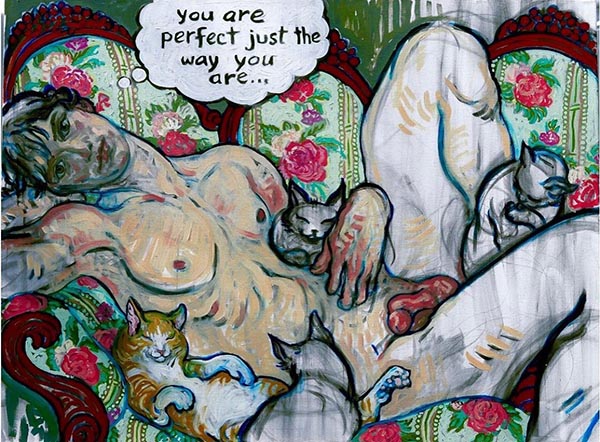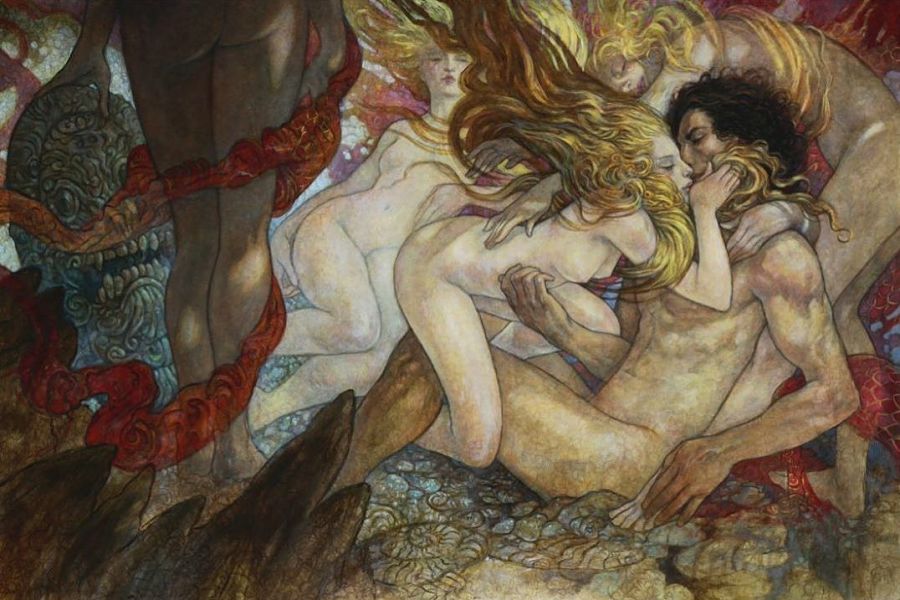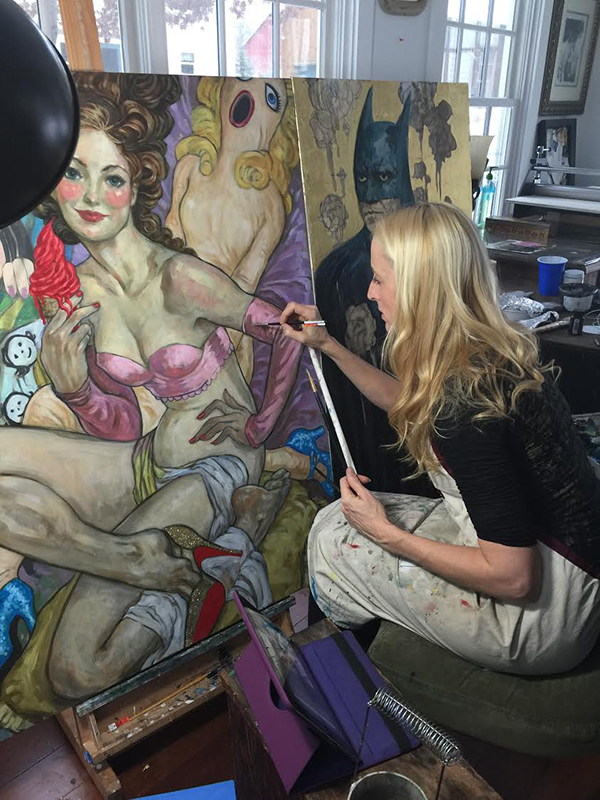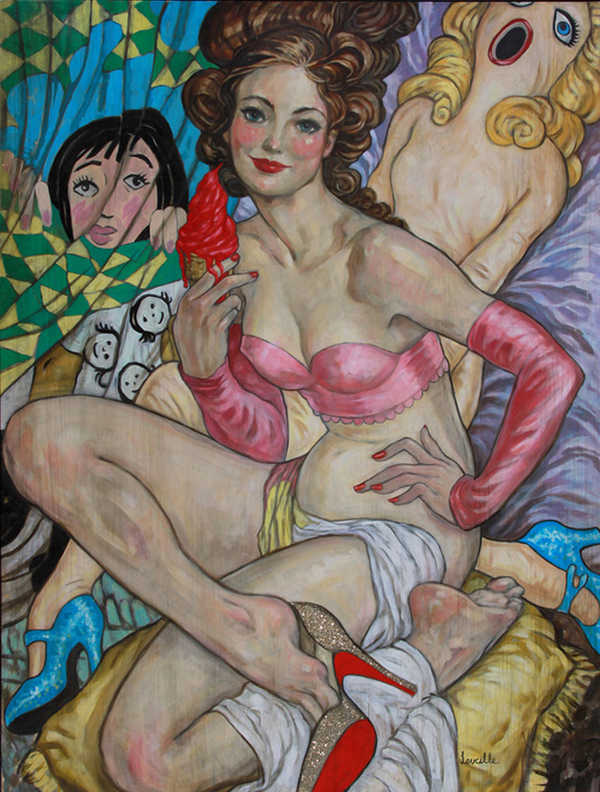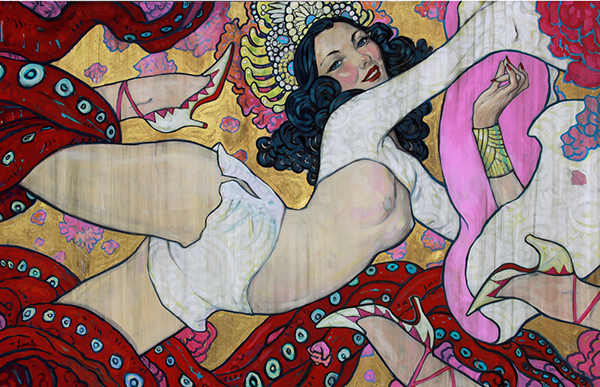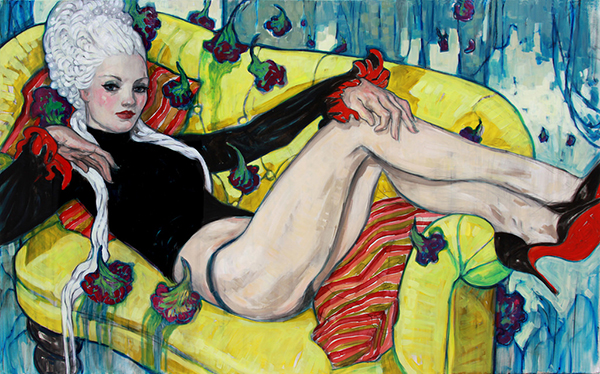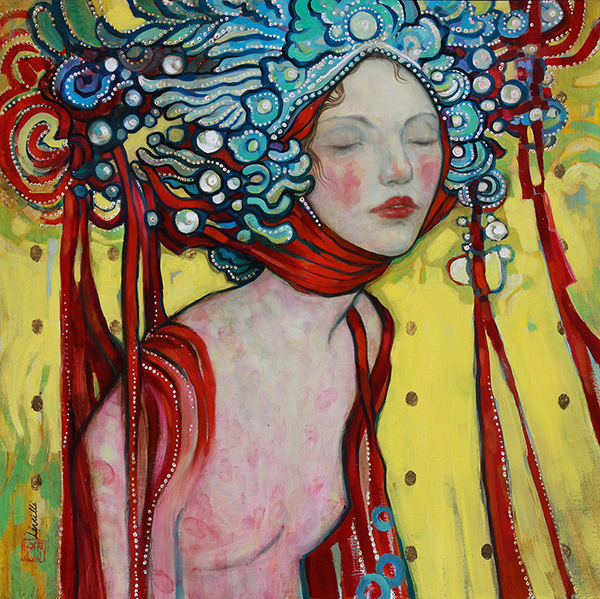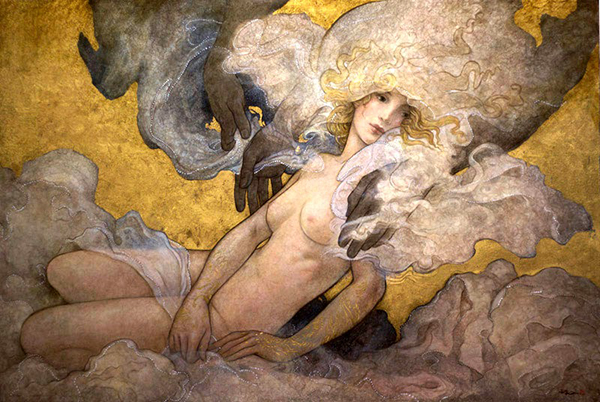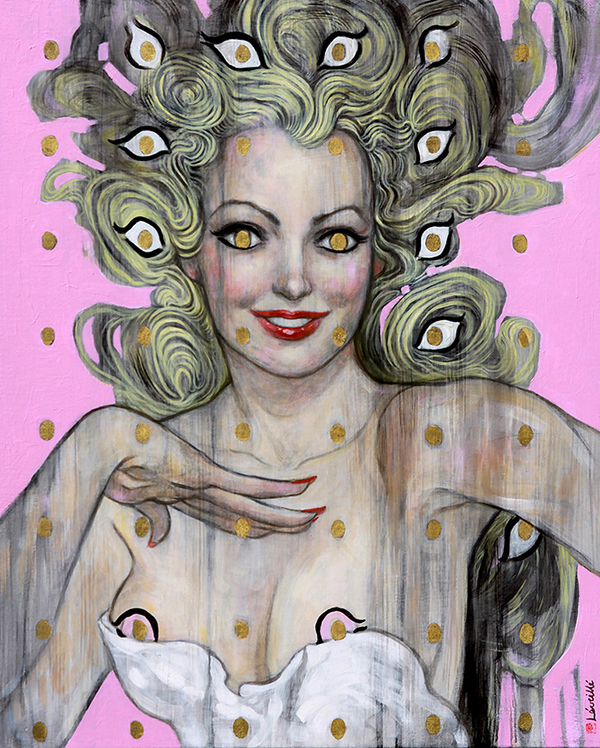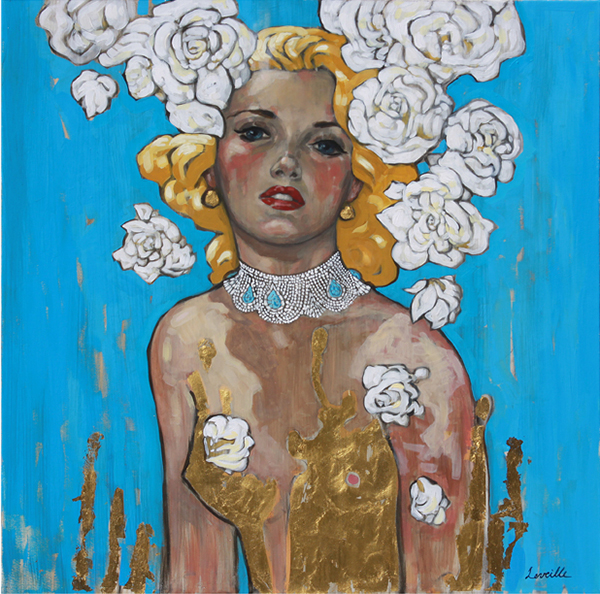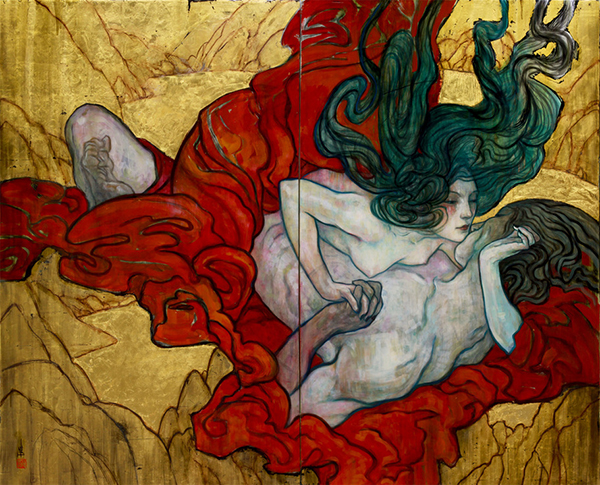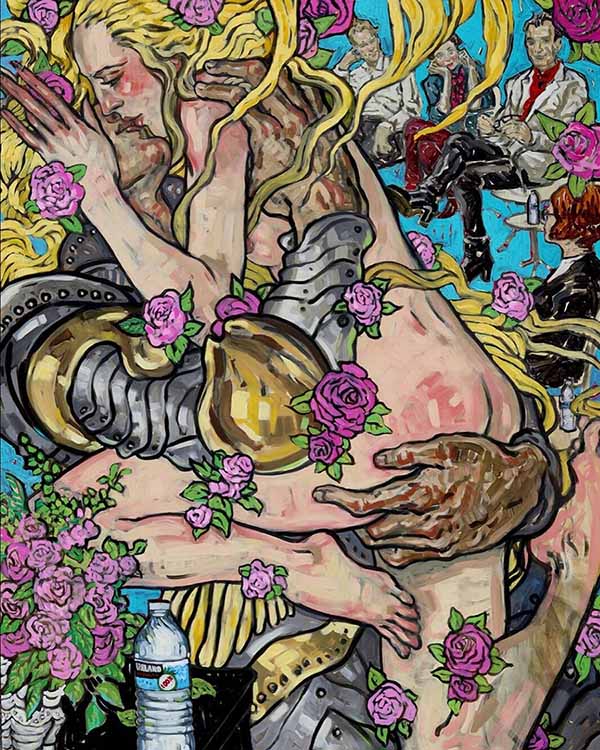Gold filigree frames the graceful outlines of curvaceous lovers, while high pigment pops of color float like champagne bubbles. This is the gorgeously intoxicating work of Rebecca Léveillé. She knew at a very young age that she wanted to be an artist. Rebecca Léveillé attended Pratt Institute and after developing herself as a talented and successful illustrator, she launched into painting works that more fulfilled her creative soul.
Interview conducted in conjunction with her editorial in Issue 15 of Beautiful Bizarre Magazine.
If you could give our readers a mini biography on your life it would be wonderful. What was your childhood like, and when did you first discover a love for painting?
As a child, there was never a question about what I wanted to do- I always wanted to be an artist. I drew ALL the time. I remember winning my first “competition” in 1st grade when we all drew a portrait of the teacher and mine won and it was blown up really big and put on the door of our classroom. It was so electrifying! My mother had gone to Mass Art in Boston, and was a supportive if tough critic. She taught me the measurements for the face and how to break down the representation of facial features really young. She praised me but also told me what I needed and could do better. She always said that I could make it as an artist but it would take a great deal of work and commitment.
As most kids I loved comics – particularly super hero comics and I soaked in huge amounts of figure information through obsessively copying people like John Byrne and Paul Smith. I also loved NC Wyeth at a really young age; we had an old copy of RIP Van Winkle that I adored.
What shaped your style, and how has your practice changed over time?
Both my style and practice evolved and changed over time. I’ve always been very obsessive and I work a great deal. I don’t work all day every day on just painting and drawing, but most days are spent that way. Even if I don’t know what to paint, I truly believe that, as Picasso said, inspiration finds you working. Getting into the studio and being present working leads to more and better work.
In terms of the inspiration and what has evolved my style over time, there have been many factors. When I went to Pratt Institute the focus in the painting department was solely on abstract expressionism, nothing figurative- so for that reason I went into illustration and got some excellent training by two particularly wonderful teachers David Pasalaqua and Jerry Contreras. I was fortunate to move quite quickly into a successful illustration career within a year or so of graduation. For many many years I worked solely within illustration, and while I have respect for it found that at a certain point I had to start making work for just myself. I no longer wanted to create images that were attached to marketing or a product. It became too hard as an artist to squeeze myself into someone else’s narratives and characters. I know some tremendous painters who work in illustration and I know that work and how to produce the work inside and out, and I have innate respect for that path, it was just not right for me any more.
So I very deliberately started to build a body of gallery work. I left illustration in late 2011 and devoted the next year and a half to just producing a body of work for my 2013 show at R. Michelson Galleries.
My first body of work, for that show, felt like it evolved from the themes of sensuality that I felt I could never go far into with the illustration work. I’m certainly proud of it as it set me on my path for my personal work. Now, I feel like I’m always pushing into what I want to say, every day that I go into the studio, digging further into the emotions that are not always pleasant or pretty or romantic. Once the door got cracked open the whole world of emotional possibly came in.
Recently, I’ve started to speak, in interviews and some talks, about some serious health problems I had as a result of succumbing to the societal temptation of trying Botox. Succumbing to the fears around aging and physical beauty that weigh so heavily on women. I had severe, systemic, debilitating side effects from the drug that affected my vision, my ability to think clearly, my nervous system, I shook and trembled constantly, I had trouble speaking, opening my eyes fully, I couldn’t drive at night because I saw halo’s on all lights – and even more things, more side effects. I could not work well or easily for months. I’m 90 % better most days now, but still recovering though it been almost 3 years.
After I started to get well, with the endless love and help of my amazing husband and daughter who were blindsided by this, and my choice to try this thing that had such awful consequences, I came back to my practice and an artist in a very changed way. I came back to the studio very fragile and in some ways very angry. I began to question beauty and what beauty means as a weight in society; the terrible grip of beauty and how it is not benign. I began to explore my own intoxication with it along side of my feelings of conflict about it. I wanted to examine and address it in a way I hadn’t before.
This is what is at the heart of much of the work in the last solo show I had, ‘The Savage Garden’ at the Corey Helford Gallery.
I feel that in the process of the production of the work I’m giving the viewer a piece of the dialogue that is in my heart – sharing my conflict – sharing my duality as it relates to ideals. I still love beauty but I question it as well, and have many complex feelings around it. Very recently I feel I am growing again, through the crucible of the experience of the ‘Savage Garden’ work, on to some other works that are more rooted in individual faces and moments – expanding on the soulful beauty of and unexpected face/person/moment.
Your work reminds me immediately of Gustave Klimt, Egon Schiele and Paul-Émile Bécat. There is not only the gorgeous gold details, lovely lilting line-work, but also a lush romanticism and sensuality. What draws you to such intimate portrayals of love, lust, and power and why do you think other people are drawn to sexually explicit art as well?
I love the gravity of Klimt’s drawings; even the work that is not considered “erotic” work has an earthy gestural palpable sexuality in it. Klimt and Schiele have influenced a huge number of current painters and I certainly was one, especially in college. Lately, I am drawn greatly to people like Gerda Wegener, I love her fierce brave sexuality, Romaine Brooks, Lautrec, Lisa Yuskavage, and John Currin among others!
When I deal with sexuality in my work, I rarely even think of it as explicit – as its goal is not to “get off” on it. It’s meant to challenge and question points of view and how things have been represented in that past. Sexuality is just a very matter of fact thing to me; part of the whole dialogue. Not every piece in a show will address the issue but some will and that’s just a reflection on what I feel about human nature.
You stated in another interview that your works can sometimes be misconstrued as fairy tales or illustrations of past mythical events, and that this is something you hope viewers will not see within your work. What do you hope your audience will take away with them after seeing your paintings?
I like it best when viewers have an emotion reaction- that I make them think of something very personal to them. I don’t want to feel I’m giving them an entire fully told “story” whether it be a myth or a poem or anything else, I want and emotional narrative to exist in a personal way only between each viewer and the image.
While I have a love for illustration, my mission now is not illustrating stories or directly identifiable narratives any more. This “looks Like… (x artist x story x poem x myth)” is a phase I never want to conjure in people minds I’m more interested in and always striving for “This FEELS like…”
There is an overwhelming stereotype of the artist that one needs to suffer in order to create great art. What are your thoughts on how artists deal with stereotypes and expectations?
I can only speak on my own experience and I know that as an illustrator I did not suffer much. I got the assignment, I did the best more heartfelt piece I could, and then sent it out into the world.
When I sketch or think or paint now, I feel like a raw nerve for the most part. If people like it, it feels amazing if they don’t it feels terrible, because the “buck stops with you” so to speak, not writer or art director or other party is involved so that you can say to yourself – well that was the way it had to be, what I had to paint so I’m not going to take it personally. Everything feels so personal now.
As a gallery painter though, it’s essential to emotionally separate myself from my need for people to like the work, try not to work for approval, but try to make something that feels entirely true to you. I think this is a very hard thing to do. I struggle with it ALL the time.
You’ve stated that you like to take contemporary and historical sexist imagery and skew it into something from the female point of view. What is your take on the current gender issues facing society today, and as a female painter, how do you traverse the often male-dominated art world?
This is a big question. Its SO big.
The history of art from Titian to Currin has been, for the most part, 1000 years of the male gaze on the female form. A male interpretation of female sensuality. There are very few sensualised male forms from a female perspective in art history or even current art. Female artists often paint other sensualised female forms as well- its like it been digested into us.
The Flowers painting attempts to be a counterpoint to all those paintings of nude, nubile, flushed, rosy breasted, arch backed (all indications of female arousal) depictions of women throughout all of art history. In my mind, the male version of the sensualised, idealized female form is the male in the ‘Flowers’ painting.
I view my perspective as a women painter working now within the art world as a magnificent opportunity and the only thing that stands in my way is my not being brave enough myself to make the choices that I need to make for the work and what I want to say. To be brave enough to not shy away from the imagery and find a nuanced and evocative way to bring across what I want to say.
Many people view art school as an expensive waste of time, however your in-depth knowledge of art history creates a dimension in your work often missing in other contemporary works. As an alumni of Pratt, how do you feel that that experience shaped your present? Is arts education an important aspect of society?
In my perfect world scenario I would say two years of organized art school training, a smoking awesome foundation year and one additional year for focus where you think you want to go, and then get directly into a mentorship with a successful working artist for another two to three years.
Your works also hark to Japanese printmaking, including Shunga. Your painting ‘Time and Chance’ reminds me beautifully of ‘The Dream of the Fisherman’s Wife’. What concepts, artists, or styles fuel your inspiration, and how do you so gracefully take something old to create something new?
All we can do as artist is take the collective images, emotions, and expressions, compositions from the past and the present, and soak in all of the things that matter to us. How me make it contemporary is by being honest and allowing alchemy of how these thing create a perfect storm within us – a unique storm that is specific to each of our individual make ups- and then put forth into the painting the outcome of this internal alchemy.
Do you have any advice for artists out there who are trying to find their place in the art world?
Inspiration finds you working, you wont get to the next great painting by perfecting it in your head first. A great painting happens when you’ve finished 500 terrible drawings then 500 not terrible drawings then 100 terrible paintings and then done 100 less terrible ones then 100 pretty good ones… and so on an so forth until you know yourself and your craft and your heart.
Be aware of what you don’t know in your work so you can seek the right information to improve.
Be social and friendly and interested in other peoples work. Go to openings and ask questions and care about the answers. Remember names, take and have business cards, follow up with people you meet and liked within a week of any meeting. Be able to speak about your own work with confidence, be able to talk quickly about several relevant contemporary artists you admire.
